
In today's racing world, we have pre-built shocks available with any number of combinations of disk designs and valving. Some types of designs provide the ability to adjust shock rates quickly at the race track. With all of these choices, we have what we need to choose the exact rate of compression and rebound necessary for a particular set of conditions. This can either be an advantage or the proverbial "enough rope to hang..." syndrome. The more we learn, the better we can make decisions regarding shock selection.
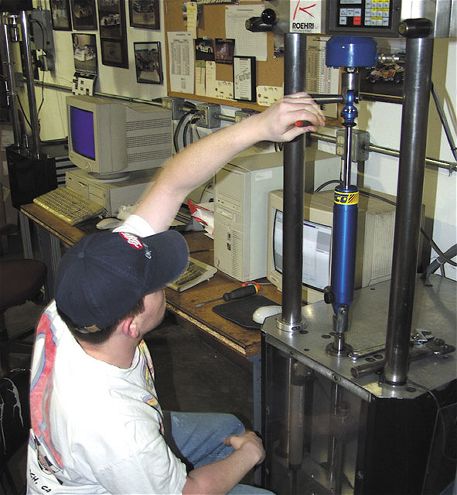 Performance gains are possible by knowing how shocks will affect chassis movement and weight transfer. It is important to know our shock rates and how different rates produce desired effects. Proper shock mainten-ance helps us to be sure that parts are working and our shock rates have not changed.
Performance gains are possible by knowing how shocks will affect chassis movement and weight transfer. It is important to know our shock rates and how different rates produce desired effects. Proper shock mainten-ance helps us to be sure that parts are working and our shock rates have not changed.
More and more, racers are being educated in all aspects of chassis tuning and they want to know more about shock technology. The more we know about each of these subjects, the less fear we have. It is what we don't know that we fear the most.
The information presented here is intended as a guide to help you understand the basic principles of shock technology and the art of track tuning with shocks. Exact rates for the shocks you need for your car will depend on how your car is constructed, set up, and driven, as well as factors such as weight distribution and race track characteristics.
We would really like to give you the exact shock values that will make your car as fast as it can be, but that would be impossible due to the many variables. Those variables are why you must work with your particular car and not follow what others are doing. Each car is a little different than the others and each driver has his/her own style of driving.
Part One dealt with the basic construction of the racing shock. We learned that the two strokes of the shock, rebound and compression, are looked at separately and perform functions related to different areas of track tuning. If we deal with rebound and compression separately, we need to be able to tune each independently. There are also different designs of shock pistons including the linear design and the digressive design. Again, we are able to achieve varying results by utilizing all of the variables of shock design.
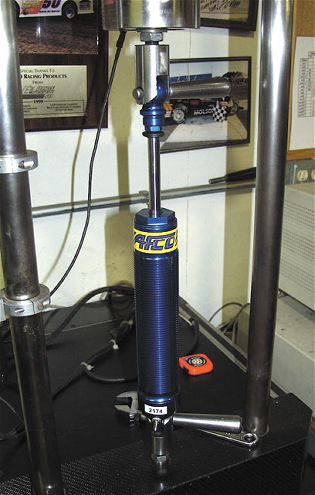 When a shock is run on a dyno, it is cycled at different speeds and the resistance is accurately measured by load cells. It is important to go through this process to know the true rating of each shock, and to insure that every part is working properly. All shocks should be inspected, rebuilt and dyno'd at least once a year.
When a shock is run on a dyno, it is cycled at different speeds and the resistance is accurately measured by load cells. It is important to go through this process to know the true rating of each shock, and to insure that every part is working properly. All shocks should be inspected, rebuilt and dyno'd at least once a year.
For some situations, we would use split valve shocks. Split-valving means we have different rates of resistance for rebound and compression because we need to tune each movement a little differently than the other. We can also rate the two movements differently for each corner of the car to further tune the setup. If we want, we can buy (at a greater expense) shocks that have external adjustments for rebound, compression, or both (called double adjustable). That way, we can experiment with different shock rates without removing them from the car. Regardless of how we arrive at different shock rates, we do need to know beforehand what we are looking for and how to get there.
Shock companies provide a system of numbers or letters to reference the rates of rebound and compression. Most of these companies try to provide a cross-reference so that their numbering system can be compared to the other systems used by competing shock brands. The ultimate match between shock brands is not exact due to differences in design of the valving and the fact that companies will rate shocks at a different shaft speed.
If, for example, a "3" shock or an "A" shock were rated by each manufacturer at 100 pounds of resistance, comparing them would depend on what speed of movement each company rated that 100 pounds. We know the rate of resistance is directly related to shaft speed. Company X might rate the 100 pounds at 5 inches per second of shaft speed where company Y might rate the 100 pounds at 10 inches of shaft speed. We can see where the two would not feel the same to the driver. The X shock might well be 150 pounds of resistance at 10 inches per second of shaft movement where as the Y shock might be only 75 pounds of resistance at 5 inches per second of shaft movement.
To simplify things, we will use the numbering system to relate to the amount of rebound and compression, the smaller number representing less resistance. Because we are not telling the exact rate in pounds of resistance for each number, the comparisons and trends will be good for either a dirt or asphalt stock car. Generally speaking, dirt cars require a softer overall package than asphalt cars.
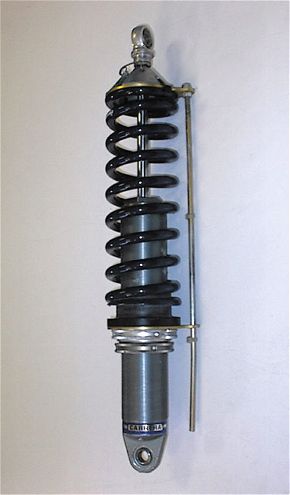 A shock that moves in direct proportion to the spring moves at the exact same speed as the spring. This is especially true with the coilover design. On some designs, the shocks and springs are mounted at different distances from the ball joint and move at different speeds in relation to the wheel speeds.
A shock that moves in direct proportion to the spring moves at the exact same speed as the spring. This is especially true with the coilover design. On some designs, the shocks and springs are mounted at different distances from the ball joint and move at different speeds in relation to the wheel speeds.
A basic starting shock setup for a medium-banked race track might be a pair of "six" shocks on the front and a pair of "five" shocks on the rear. These would be true 50/50 shocks where the resistance in either direction, rebound or compression, would be equal. If the shocks were the split-valve design, each shock would be numbered as say a 6/5, which for our purpose means that the first number will represent the rebound resistance and the second number will represent the compression resistance.
Controlling wheel movement would be much easier if the shocks were all we had to work with. But in reality, our race cars are supported by a set of springs. If we wanted true equal resistance to wheel movement with the shocks installed along with the springs, we would want the rebound resistance to be greater than the compression resistance (reference Part One - July, 2003 issue - where we said that springs promote rebound and help provide resistance to compression). As we install stiffer springs, we will naturally increase the rebound resistance and decrease the compression resistance.
The more balanced shock layout might look like this: Front shocks = 6/5, rear shocks = 5/4. The greater rebound helps control the force of the preload on the spring as it is released and the softer compression works along with the resistance to compression provided by the spring.
High-Banked Setups
For a setup that uses higher-rated springs in the front and rear for a higher-banked race track, we might use a pair of 6.5/4.5 shocks on the front and a pair of 5.5/3.5 shocks on the rear. That is because the higher rating in the springs promotes rebound and therefore we increased the rebound resistance. The higher spring rates also resist compression and so we can reduce compression resistance in the shocks.
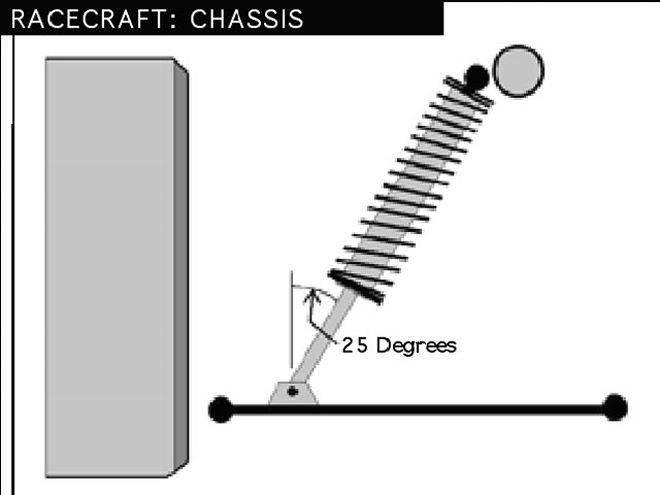 For a shock installation such as this coilover design, the shock/spring combination will move at a slower speed than the wheel. If the speed of the movement of the wheel were 5 inches per second, then, due to the motion ratio and the shock installation angle of the shock/spring, the shock speed would be only 3.82 inches per second.
For a shock installation such as this coilover design, the shock/spring combination will move at a slower speed than the wheel. If the speed of the movement of the wheel were 5 inches per second, then, due to the motion ratio and the shock installation angle of the shock/spring, the shock speed would be only 3.82 inches per second.
When the banking of the race track is very high, say 18 degrees or more, we need split valving, but we would go up on both the rebound and compression rather than up on rebound and down on compression. The reason is that the turn speeds are much higher on the very high-banked tracks and the shocks will move much faster in both the transitional areas of entry and exit, and also as the car goes over bumps and dips in the race track. Without the higher level of control, the suspension might bottom out with obvious negative results.
A more realistic layout for a very high-banked track might be a pair of 6.5/5.5 shocks on the front and a pair of 5.5/4.5 shocks on the rear. We have increased the resistance for both rebound and compression as well as introduced split-valving to a degree.
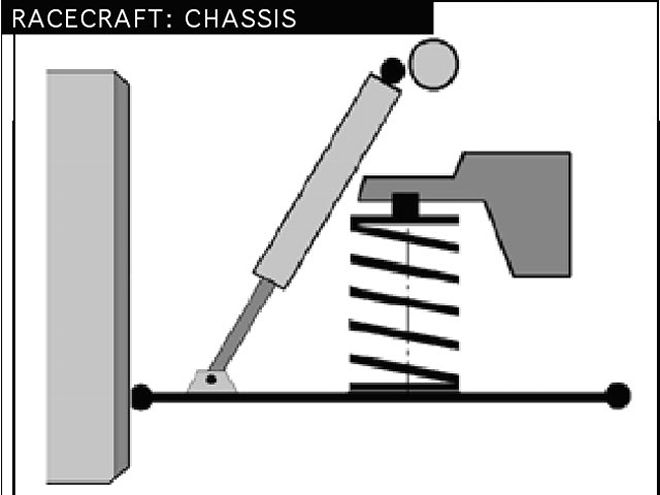 On many big-spring stock-clip stock cars, the speed of the wheel, the shock and the spring are all different. If the wheel were moving at a speed of 5 inches per second, the shock would be moving at 3.82 inches per second and the spring would move at 2.65 inches per second. If the shock were mounted farther from the ball joint, then it would need to be designed with a higher rate of resistance for both rebound and compression.
On many big-spring stock-clip stock cars, the speed of the wheel, the shock and the spring are all different. If the wheel were moving at a speed of 5 inches per second, the shock would be moving at 3.82 inches per second and the spring would move at 2.65 inches per second. If the shock were mounted farther from the ball joint, then it would need to be designed with a higher rate of resistance for both rebound and compression.
Low-Banked Race Tracks
For low-banked race tracks, we would need to spring the car much softer to slow down all of the movements in order to help maintain traction. One of the basic ingredients needed to maintain grip at low-banked tracks that have less grip is to soften the whole setup, including spring rates and shock rates. As we soften the springs, we will also soften the front shocks to say 5/4 valving and the rear shocks to a pair of 4/3 shocks. This is the general way shocks can be matched to the stiffness of the spring setup.
One exception is when we go beyond the normal softening of the springs into what has become known as the "soft spring - big sway bar" setups that have become popular in short track asphalt racing. These setups often use super soft springs in the front and, to help control dive on entry, the teams must increase compression resistance to overcome the tendency for the car to bottom out as we brake and turn left on entry into the corners. Here is where we might go back to the true 50/50 shocks. The debate is still on as to whether there is a need for the SS-BS setups and it has definitely been realized that those setups do not work in all situations.
Entry Tuning with Split-Valve Shocks
If we split the front shock compression rates with a left front (LF) 5/4 and a right front (RF) 5/5, then while the suspension is in motion due to weight being transferred onto it, then the RF suspension will move slower than the LF suspension. Additional weight will be transferred onto the RF and LR tires, causing a momentary increase in the crossweight percent in the car. This obviously tightens the car.
It is important to note that, contrary to some opinions, the weight transfers almost immediately when a force is presented to enact that transfer. As we brake into the corner, the weight transfer happens quickly. If we transfer 300 pounds on entry from the rear to the front, the 300 pounds goes to the front in an instant. The distribution of that 300 pounds between the two front wheels, while the suspension is assuming a new attitude that will support the additional weight, will depend entirely on differences in stiffness of the suspension systems at all four corners. Stiffness is defined as the resistance to movement of the shocks and springs.
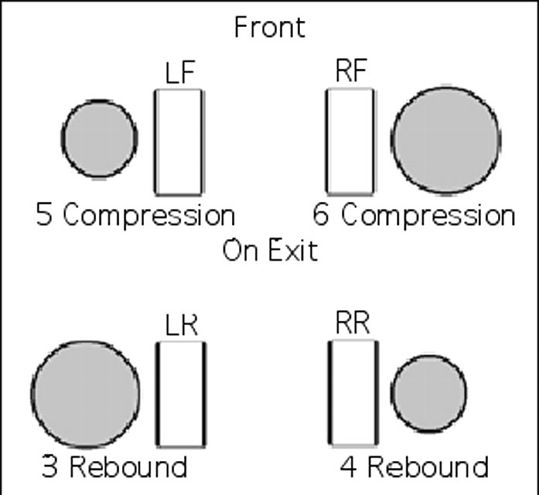 By using split-rate shocks between pairs on each end of the car, we can tighten the car on entry to the corner. If the RF shock is stiffer in compression than the LF, and/or the RR shock is stiffer in rebound, then the crossweight percent (RF + LR combined weights) will increase momentarily while the suspension is moving and adjusting to the transfer of weight due to deceleration.
By using split-rate shocks between pairs on each end of the car, we can tighten the car on entry to the corner. If the RF shock is stiffer in compression than the LF, and/or the RR shock is stiffer in rebound, then the crossweight percent (RF + LR combined weights) will increase momentarily while the suspension is moving and adjusting to the transfer of weight due to deceleration.
Reasoning out the effect of weight transfer onto the front suspensions that are dissimilar in stiffness, the slower moving (or stiffer) corner will momentarily retain more of the transferred weight while the suspension is moving to a new attitude to support the added weight. If the RF suspension is stiffer than the LF suspension, then both the RF and LR tires will support more of the total sprung weight of the race car.
Crossweight is defined in short track racing as the percent of the combined RF and LR weight versus the total vehicle weight. If the crossweight percent increases, the car will be tighter on entry and the car might be faster if that is the desired effect. This is exactly why it has been said that a stiffer RF shock will speed up weight transfer to that corner. In truth, some of the momentary weight that has been transferred onto the RF due to that corner being stiffer than the LF corner may well return to the LF tire as the car reaches a steady state or a steady ride height at mid-turn.
If the car is already tight on entry, after having eliminated common causes of tight entry such as rear misalignment or brake bias issues, an opposite effect can be utilized. If we increase the compression of the LF shock and/or increase the spring rate on that corner (which is usually a good idea for flat tracks), we can effectively reduce the crossweight in the car on entry while the suspension is in transition by loading the opposite diagonal, the LF and RR. As one diagonal goes up in percentage of supported weight, the other goes down. We can also work with the rear shock rebound rates to help effect changes in weight distribution and corner entry characteristics. To neutralize a car that is tight on entry, a stiffer rebound setting in the LR shock and/or a softer rebound setting in the RR shock will cause more of the transferred weight to be taken from the LR than the RR tire during the transitional period. This too causes a decrease in the RF and LR weight distribution percentage that loosens the handling momentarily while the suspensions are in motion.
Exit Tuning Using Split-Valve Shocks
Corner exit performance that utilizes the shocks is primarily tuned by splitting the compression settings in the rear shocks and/or the rebound settings in the front shocks. A stiffer compression setting in the LR shock will load the LR and RF corners as weight is transferred to the rear while the rear suspension is in motion. A stiffer shock in rebound at the LF corner can help accomplish the same effect by causing a slower movement of that suspension and a more rapid transfer of weight off of that corner which in turn increases the percentage of weight supported by the RF and LR tires.
The term "tie down" is often used to refer to a shock that has a high resistance to rebound. If the rebound rates are higher for both left side shocks than those of the right side shocks, then as the car turns left (especially with quicker turning rates associated with smaller radius turns), the tendency for the left side suspensions to quickly rebound as weight is transferred from the left side to the right side is reduced.
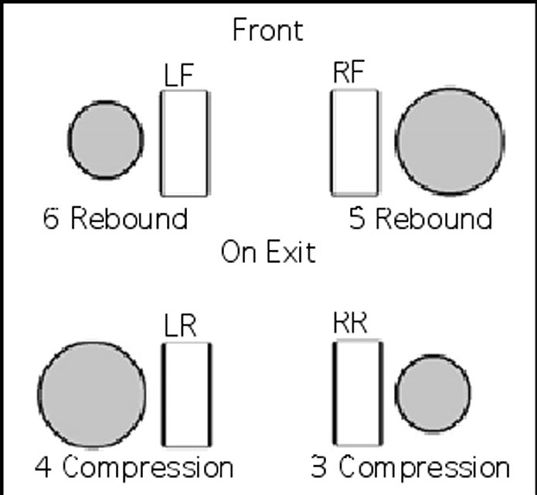 By using split-rate shocks between pairs on each end of the car, we can tighten the car on exit off the corners. If the LF shock is stiffer in rebound than the RF, and/or the LR shock is stiffer in compression than the RR shock, then the crossweight percent (RF + LR combined weights) will increase momentarily while the suspension is moving and adjusting to the transfer of weight due to acceleration.
By using split-rate shocks between pairs on each end of the car, we can tighten the car on exit off the corners. If the LF shock is stiffer in rebound than the RF, and/or the LR shock is stiffer in compression than the RR shock, then the crossweight percent (RF + LR combined weights) will increase momentarily while the suspension is moving and adjusting to the transfer of weight due to acceleration.
If we can stop the sudden motion, we can keep the left side down on initial turn in and the chances are good that the whole attitude of the car through the middle of the turns will be lower. A lower center of gravity (CG) means less weight transfer off the left side of the car and more retained left side weight. For asphalt stock cars and dirt cars on higher-banked tracks with grip, a higher left- side weight means more equally loaded tires, left to right, and more traction. The opposite is true of dirt cars on slick tracks.
The reverse term, or "Easy Up" shocks, are used to help raise the suspension quickly which does also raise the center of gravity of the sprung mass and a higher CG promotes more weight transfer. Drag cars use this effect on the front of their cars to promote more weight transfer to the rear tires for added traction. On dry, slick dirt tracks, teams can utilize less rebound in the left side shocks and in the front shocks to promote weight transfer to the right side for better side bite and to the rear for better traction off the corners.
Putting All Of This to Use
In order to utilize the configurations we have discussed here, we must be able to use a range of different rates of shocks in order to find the right combination for our car at a particular race track. For a team that races at only one track, the process is fairly simple. You would experiment to find the fastest set of shocks and ones that suit the driver's style and stick to those. For teams that travel to different tracks, some changes will be necessary if the setup needs to change and/or the track layout is different from track to track.
Many shock experts agree with certain basics, such as:
1. The shock package should be softer overall when racing on dirt and when the track is flatter when on asphalt.
2. Get your basic setup close to being balanced before trying to tune with shocks. Shocks cannot solve basic handling balance problems.
3. Higher-banked tracks require a higher overall rate of shock as opposed to flat tracks. This is because of the higher speeds and the extreme amount of downforce.
4. Shocks that are mounted farther from the ball joint should be stiffer than if they were mounted close to the ball joint. With each inch of travel of the wheel, the shock mounted farther away will move at a lesser speed, meaning less resistance to both rebound and compression.
5. Tune entry performance first. If there are no entry problems, make small changes if you want to experiment to see if entry can be improved. Entry problems include a tight car or a loose car. The worst problem, by far, would be the loose-in condition. Nine times out of 10 this is an alignment problem and not shock related.
6. Tune exit performance last. If there are no exit problems, don't make any significant changes. Exit problems can include a car that pushes under acceleration or one that goes loose under power. Be sure that you do not have a tight /loose condition where the car is basically tight and goes loose just past mid-turn.
7. On dirt tracks, reduce rebound settings on the left side and decrease the compression rates on the right side for dry, slick surfaces to promote more chassis movement. This helps to maintain grip as the car goes through the transitional phases of entry and exit.
8. On asphalt tracks, once the car has been tuned with shocks for optimum entry and exit performance, increase the overall rebound rates a small step at a time, especially on the left side, to possibly increase overall performance. This is especially good for low- to medium-banked race tracks. For highly- banked tracks, the added rebound is not necessary or advisable.
A Closing Caution
The suggestions provided here are representative of trends that can enhance your handling package. Before any of this can work, the setup must be balanced, the steering characteristics must be ideal, and the car must be aligned properly. If not, you will probably chase the setup and experience a lot of frustration and expense. Shock tuning is the last thing to experiment with in order to try to increase your race car's performance, but it is nonetheless a necessary step in finding the ideal total handling package.